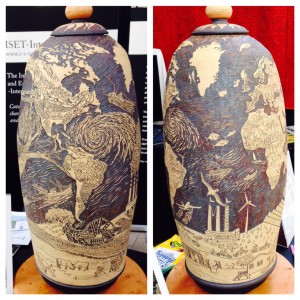The latest cry for our individual and collective attention on climate change
One of the most high profile advocacy groups fighting to curb greenhouse gas emissions is 350.org, whose name embodies the goal of the organization. At around 350 PPM of CO2 in our atmosphere we are ensured a livable planet. Above this, we embark on a grand experiment. One where we cannot know all the outcomes but have a growing understanding of the consequences of destabilizing Earth’s climate.
Recently we learned that for the first time in millions of years, CO2 levels in our atmosphere reached and remained at 400 PPM (for all of March). 2015 is predicted to be the hottest year on record and actual data from the first four months are upholding the prediction. To add insult to injury, we are experiencing an El Niño event which, driven by warm ocean temperatures in the Pacific, tends to cause more extreme weather over much of the globe.
I try to keep my communications on climate focused on solutions and hope. I have to say, this 400 number has me thrown for a loop. The number itself is not any more significant than say, 399 or 401. But, what it does represent is a warning signal—a number that should cause alarm and provoke thought on what exactly we are or are not doing to slow the rise of this number. If 350 PPM represents the safe zone, what is 400? What is 450? How fast are we heading in that direction? Climate scientists regularly model different future scenarios that account for changes in the amount of CO2 we emit through the burning of fossil fuels. Reaching 400 PPM in 2015 has us clearly aligned with the highest (business as usual) emissions scenario. In spite of all we know, we are more or less proceeding as before.
I just returned from a week of inspiring talks and conversations on how communities throughout the nation are preparing for climate change at the National Adaptation Forum (NAF). The conference provides a forum for sharing and learning how people and governments are implementing practices that will help our towns and cities adapt to climate impacts like more drought, higher heat, severe storms and higher sea levels. The existence of an event like this (attended by over 800 adaptation professionals) illustrates how people throughout our country are acknowledging the need to prepare for a future where the weather looks significantly different from the past. I’ve come home from this conference each time, with a renewed sense of hope and energy to help my work here at HRWC.

This year however, with the conference coinciding with the 400 PPM milestone (forgive me) there has been a little rain on my parade. It reminds me, that though adapting to a new climate is essential at this point in the game, we cannot, must not, lessen our efforts to curb global greenhouse gas emissions. As the country that is responsible for 25% of global emissions each year, the weight is heavy on our shoulders here in the US. Continue to take personal action to reduce your carbon footprint (here are some ideas pertaining to water) and consider participating in a vocal advocacy group like 350.org to help apply pressure at the national and international level for action.
At NAF, artist Chris Moench displayed two prayer wheels (a Tibetan Buddhist tradition) he created as part of an ISET’s Resilient Narratives project. One with art to reflect a positive future. The other to represent the threat. Conference participants were asked to contribute their hopes, wishes, prayers, promises, to the urns. What are your hopes for the future? What would you contribute to the prayer wheel? And what can you do to help us collectively get there?



